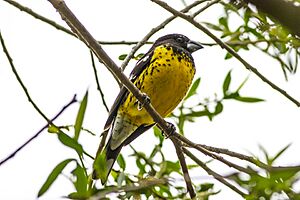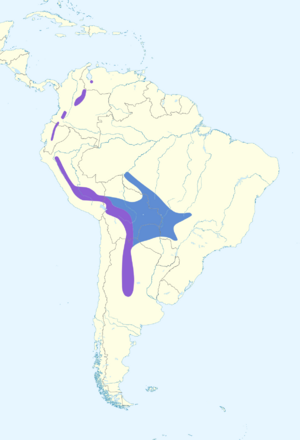Black-backed grosbeak facts for kids
Quick facts for kids Black-backed grosbeak |
|
|---|---|
 |
|
| Conservation status | |
| Scientific classification | |
| Genus: |
Pheucticus
|
| Species: |
aureoventris
|
 |
|
| Year-round
Non-breeding |
|
The black-backed grosbeak (Pheucticus aureoventris) is a cool bird that belongs to the Cardinalidae family. This family includes cardinals and other grosbeaks. You can find this bird in several South American countries. These include Argentina, Brazil, Bolivia, Colombia, Ecuador, Paraguay, Peru, and Venezuela. Sometimes, people even keep them as cagebirds.
Contents
About the Black-backed Grosbeak
Different Types of Grosbeaks
Scientists have identified five different types, or subspecies, of the black-backed grosbeak. They are all very similar, but live in slightly different areas.
- P. a. meridensis
- P. a. uropygialis
- P. a. crissalis
- P. a. terminalis
- P. a. aureoventris
Some scientists think the black-backed grosbeak might be very closely related to the golden grosbeak (Pheucticus chrysogaster). Their homes overlap in Peru.
What Does It Look Like?
The black-backed grosbeak is about 22 cm (8.7 in) long. It weighs between 43.8 to 66.2 grams (1.54 to 2.34 oz). That's about as long as a ruler!
Most of the subspecies look very much alike.
- Males have black backs and a bright yellow patch on their shoulders. Their closed wings show white spots. Their chin, throat, and upper chest are also black. The lower chest and belly are bright yellow. They might have some black spots on their sides.
- Females look similar but are browner. They have yellow spots on their upper side and dusky (darkish) speckles underneath.
One subspecies, P. a. crissalis, is a bit different. It has a yellow chin, throat, and upper chest, where the others are black.
Where Do They Live?
The black-backed grosbeak lives in the eastern Andes mountains. Each subspecies lives in a specific area. Most of them stay in one place all year.
- P. a. meridensis lives in the Mérida state in northwestern Venezuela.
- P. a. uropygialis is found in the Eastern Andes of Colombia.
- P. a. crissalis lives from Colombia's Nariño Department south to central Ecuador.
- P. a. terminalis is found in Peru's departments of Amazonas and Cuzco.
- P. a. aureoventris breeds in Peru's Puno Province, western and southern Bolivia, and northwestern Argentina. In the winter, it moves into west-central Brazil and northern Paraguay.
These birds like dry woodlands, which can be scrubby or open. You can often spot them in gardens too! In Venezuela, they usually live at heights from 1,450 to 2,000 m (4,760 to 6,560 ft). Sometimes they are found as high as 3,700 m (12,100 ft). In Colombia, they live between 1,700 and 3,000 m (5,600 and 9,800 ft). In Peru, they are mostly found from 1,200 to 3,200 m (3,900 to 10,500 ft). At the southern end of their range, they can be found as low as 600 m (2,000 ft).
Black-backed Grosbeak Behavior
What Do They Eat?
The black-backed grosbeak enjoys a varied diet. They eat berries, seeds, flowers, and insects. They usually look for food alone or in pairs. However, several birds might gather in a tree that is full of fruit. They mostly forage high up in trees, but you can see them at any level. They do not join other bird groups when looking for food.
How Do They Breed?
We don't have a lot of information about how these birds breed. But we do know that they have been seen breeding between November and January. This includes finding adults ready to breed, nests with eggs, and young birds that have just left the nest.
Their nests are like open cups. They are made of vine stalks and lined with soft fibers. They place these nests up to 3 m (9.8 ft) high in a bush. A bird called the plush-crested jay (Cyanocorax chrysops) often tries to eat eggs or chicks from their nests.
What Do They Sound Like?
The black-backed grosbeak has a beautiful song. It's described as "a rich, melodious series of whistled notes" [1]. Their call is a sharp sound, like "keck" [2].
Status of the Black-backed Grosbeak
The IUCN (International Union for Conservation of Nature) has looked at the black-backed grosbeak. They have decided it is a species of "Least Concern." This means it is not currently in danger of disappearing.
The number of these birds varies across their home range. They can be uncommon in some places and common in others. However, they are sometimes caught to be kept as cagebirds.


